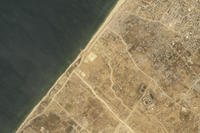FORT BENNING, Ga. – It’s been about eight years since the U.S. Army first deployed its smart-soldier technology to war. Now soldiers are finally viewing this digital, situational-awareness gear as a trusted piece of soldier kit.
The Army’s Experimentation Force, made up of soldiers from the 1st Battalion, 29th Infantry Regiment here, recently tested the wearable, command and control gear known as Nett Warrior Future Initiative during the Army Expeditionary Warrior Experiment.
The Nett Warrior system is a Samsung Galaxy Note II smartphone worn in a chest-mounted pouch and connected to networked radio such as a Harris Falcon III AN/PRC-152A wideband networking handheld radio or the older General Dyanamics AN/PRC-154A Rifleman Radio.
Without getting too far into the weeds, Nett Warrior Future Initiative is equipped with a special software package that helps the system handle multiple intelligence, surveillance, reconnaissance sensor feeds such as video streams from unmanned aerial systems.
So a platoon leader can share these video streams from a company-level Raven UAS and a platoon-level InstantEye UAS with his squad leaders.
Spec. Erin Broihier, a radio operator with A Company, said he has been impressed by how much Nett warrior has improved over the past four AEWEs.
“Every time they have brought it back, it has gotten better and better and better,” he said.
Nett Warrior evolved from the Army’s long-gestating Land Warrior program. Army officials began working on that system in the mid-1990s and over the next decade struggled with reliability and weight problems.
Land Warrior was largely a success on its first combat deployment to Iraq in 2007 with the Stryker soldiers from the 4th Battalion, 9th Infantry Regiment. The system was also deployed to Afghanistan with the 5th Stryker Brigade Combat Team, 2nd Infantry Division.
The technology allowed small-unit leaders to track subordinates’ locations in relation to their own position via icons on a digital map. They could view satellite imagery and even send text messages. Land Warrior gave leaders a more precise view of their tactical environment, empowering units to operate more decisively than ever before.
But it took a lot of training for soldiers to become comfortable with the complex system. Land Warrior was plagued by connectivity problems and at 10 pounds it added too much weight to heavy soldier loads.
By comparison, Nett Warrior is much more streamlined and weighs under five pounds. The fold-down smart-phone has replaced Land Warrior’s helmet-mounted eyepiece display.
It doesn't freeze up like Land Warrior tended to do multiple times during a mission, said Staff Sgt. Andrew Smith, a squad leader with 1st Platoon, A Company.
“It’s small, lightweight and the navigation is spot-on,” he said.
Sgt. 1st Class Chad Emerson, A Company’s platoon sergeant said he loves Nett Warrior, but the 40-hour training program for system is way too in-depth.
The training focuses too much time on tactics, techniques and procedures that always tend to vary from platoon to platoon.
“We need more updates in trouble-shooting techniques” such as what to do when it won’t display the positions of fellow leaders equipped with Nett Warrior.
Nett Warrior does take getting used to, according to Broihier, who said it is difficult to maintain light discipline when using the fold-down, chest-mounted smart phone at night.









